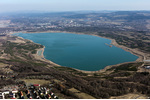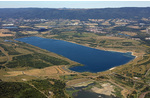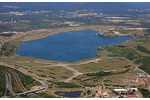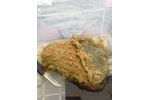Monitoring of the post-mining lakes in the North Bohemia. New study focused on microorganisms and phosphorus.
Crystal-clear water and dense algal mats covering the lakebed – that is how the littoral zones of newly emerged post-mining lakes in the North Bohemia look like. Water quality and development of the young ecosystems have been monitored by hydrobiologists from Biology centre of the Czech Academy of Science (BC CAS CR). In the new study published in the Frontiers in Microbiology they investigated the process of phosphorus uptake from the lake-water by communities of algae and bacteria.
Phosphorus is an essential element, important for growth of terrestrial plants as well as submerge plants, algae and bacteria in the freshwater bodies. Concentration of phosphorus in the lake-water is a parameter influencing the water quality in the ecosystem. If the phosphorus concentration is low, organism with high phosphorus uptake velocity has competitive advantage. So far phosphorus uptake traits have been mostly studied for phytoplankton (microscopic algae floating in the water). Very low abundance of phytoplankton has been recorded in the oligo- to mesotrophic ecosystems of post-mining lakes Milada, Medard and Most in the North Bohemia. On the contrary very dense community of benthic algae and bacteria (also known as periphyton) is covering the stone substrate on the bottom of the littoral zone. In the ecosystem where periphyton is prominent, its contribution on the clearance of phosphorus from the lake water might not be marginal. However, the ability of periphyton to acquire phosphorus from water has not been studied yet.
Periphyton is covering the stone substrate on the bottom of the littoral zone. Photo: Biology Centre, CAS
A presented study carried out by scientists from the Institute of Hydrobiology, BC CAS was focused on developing the technique for measuring phosphorus uptake velocity and connected parameters. In the year 2019 this technique was applied for monitoring of changes in phosphorus uptake velocity in the post-mining lakes. Results show that the ability of benthic microorganisms to acquire dissolved P is decreasing with increasing phosphorus deficiency. “It is in contradiction with our expectations. Due to the prominent biomass of periphyton in the studied lakes we expected that it can acquire phosphorus more efficiently in comparison with phytoplankton. To our surprise, the opposite is true” says the first author of the study Eliška Konopáčová. In contrast with periphyton, phytoplankton is able to increase the phosphorus uptake velocity when the phosphorus concentration is decreasing. Several factors which might play the role in the contradictory behaviour of phytoplankton and periphyton are discussed in presented article.
Results bring valuable knowledge about the ecosystems of newly emerged post-mining lakes and could be of potential importance during the upcoming hydric recultivation of another mining pits.
More information can be found in the study:
Konopáčová E, Nedoma J, Čapková K, Čapek P, Znachor P, Pouzar M, Říha M and Řeháková K (2021) Low Specific Phosphorus Uptake Affinity of Epilithon in Three Oligo- to Mesotrophic Post-mining Lakes. Front. Microbiol. 12:735498. doi: 10.3389/fmicb.2021.735498
https://www.frontiersin.org/articles/10.3389/fmicb.2021.735498/full



















